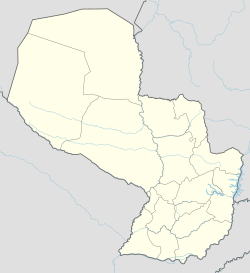| This article includes a list of general references, but it lacks sufficient corresponding inline citations. Please help to improve this article by introducing more precise citations. (June 2020) (Learn how and when to remove this message) |
| Santiago | |
|---|---|
| City | |
| Santiago | |
 Iglesia de Santiago Iglesia de Santiago | |
 | |
| Coordinates: 27°9′0″S 56°47′0″W / 27.15000°S 56.78333°W / -27.15000; -56.78333 | |
| Country | Paraguay |
| Department | Misiones |
| Re-founded | 1669 |
| Government | |
| • Intendente Municipal | Américo Romero Sanabria (Liberal Party) |
| Area | |
| • Total | 740 km (290 sq mi) |
| Elevation | 69 m (226 ft) |
| Population | |
| • Total | 7,702 |
| • Density | 9/km (20/sq mi) |
| Time zone | UTC−04:00 |
| Code Postal | 4860 |
| Area code | (595) (782) |
Santiago is a city in Paraguay, located in the Misiones Department in the south of the country.
Toponym
Originally named San Ignacio de Caaguazú, it was re-founded in the Misiones department, Paraguay, in 1669 with the name of Santiago Apostol.
History
Santiago stands as an ancient city with roots as a Jesuit mission settlement, proudly retaining the timeless traits of its colonial past. These include its expansive main square, the historically significant "house of the Indians", and a meticulously curated museum safeguarding colonial-era artworks.
In the colonial epoch, Santiago held a position of significance owing to its population, which flourished to approximately 3,000 inhabitants.
Throughout festive periods, the city orchestrated the grand spectacle of the Opera of Santiago, underscoring its cultural vibrancy and artistic fervor.
Geography
Santiago is located 278 kilometers from Asunción, the capital Paraguay. It is located on a hill between the cities of Ayolas and San Patricio.
The geography of Santiago is characterized by rolling hills, forests, and grasslands. The city is surrounded by dense forests and agricultural land, with the Paraguayan Chaco to the west and the Paraná Plateau to the east.
The Tebicuary River is an important part of the geography of Santiago, providing a source of water for agriculture and transportation. The river is also home to a variety of fish species, which support the local fishing industry.
Climate
In summer, the temperature reaches 39 °C, and in winter can drop to 0 °C. The average annual temperature is 21 °C.
The climate of Santiago is subtropical, Santiago has relatively stable warm temperatures for most of the year. There are also frequent waves of cool air from the south. This can cause the weather to alternate between clear and stormy conditions quickly. During the winter months some days and nights can be close to freezing temperatures. However most winter days are usually cool to mild. Santiago rarely sees multiple days with below freezing temperatures in any given winter. There is a distinct rainy season from October to April. This ensures the region receives ample rainfall, which supports the growth of lush vegetation and crops.
Demographics
Santiago has a population of 7,702 inhabitants, 4,017 men and 3,685 women, according to the General Direction of Polls, Statistics and Census.
References
Citations
- "Santiago, Paraguay weather in June: average temperature & climate". Wanderlog. Retrieved 2022-05-25.
- "Population of Santiago Paraguay".
Sources
- Geografía Ilustrada del Paraguay, Distribuidora Arami SRL; 2007. ISBN 99925-68-04-6
- Geografía del Paraguay, Primera Edición 1999, Editorial Hispana Paraguay SR
External links
- Secretaria Nacional de Turismo
- ABC Digital "Así es Nuestro País" MISIONES (VIII Departamento)
- Turismo en Misiones
| Districts of the Misiones Department | ||
|---|---|---|